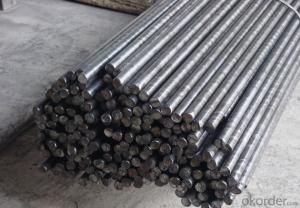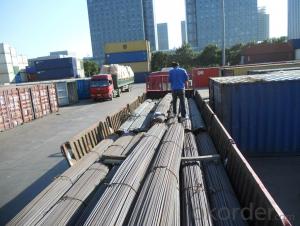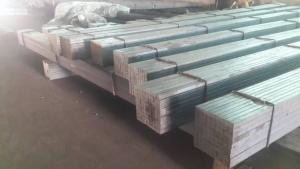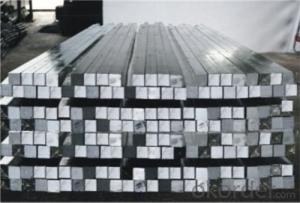Hot Rolled Round Steel Bars with Cr A36, Q235, SS400
- Loading Port:
- Tianjin
- Payment Terms:
- TT OR LC
- Min Order Qty:
- 25 m.t.
- Supply Capability:
- 200000 m.t./month
OKorder Service Pledge
OKorder Financial Service
You Might Also Like
Item specifice
Product Description:
Hot Rolled Round Steel Bars with Cr A36, Q235, SS400 is used for manufacturing ball, roller bearing steel and rings. Bearing in work is under great pressure and friction, so have high demands bearing steel and hardness and resistance, and high elastic limit.
Bearing steels are used for ball and roller bearing applications and are comprised of low carbon steels and high carbon through harden able steel.
For example, bearing ring, steel rolling mill, machinery, 100Cr6 bearing steel ball is widely used in high-speed and low-noise bearing, bicycle, motorcycle, automobile, bags electronically.
Product Applications:
Hot Rolled Round Steel Bars with Cr A36, Q235, SS400 are ideal for structural applications and are widely used in the construction of buildings and bridges, and the manufacturing, petrochemical, and transportation industries.
1. Steel round bar products is used in construction and a large number of architectural and engineering structures. And it can be used in production of handrail, windows, machinery, telecom and curtain wall.
2. It can be used in the fields like metal mines, cement plants, water coal slurry, power stations and chemical industry.
3. Besides, we can supply some especial material steel round bar that can be used for main shaft of steamer, hummer shank, with big section and supper force.
4. Recommended watchcase factory, screw factory and other cold stamping products industry use.
Product Advantages:
OKorder's Hot Rolled Round Steel Bars with Cr A36, Q235, SS400 are durable, strong, and resist corrosion.
1. The steel in which the main interstitial alloying constituent is carbon in the range of 0.12–2.0%.
2. As the carbon percentage content rises, steel has the ability to become harder and stronger through heat treating; however it becomes less ductile.
3. Regardless of the heat treatment, higher carbon content reduces weld ability. In carbon steels, the higher carbon content lowers the melting point.
4. Quality should be in conformity with the specification of the manufacturer. Quantity and packing conditions should be in conformity with the term in the contract.
Main Product Features:
· Premium quality
· Prompt delivery & seaworthy packing (30 days after receiving deposit)
· Corrosion resistance
· Can be recycled and reused
· Mill test certification
· Professional Service
· Competitive pricing
Specifications of Hot Rolled Round Steel Bars with Cr A36, Q235, SS400
1. Grade: Q235, A36, SS400, S235JR
2. Feature: Unbreakable, grinding resistant and high impact value
3. Diameter: 8mm-150mm
4. Performance: Mainly for civil construction
5. Characteristics: Even hardness, no deformation, no breaking, no mal-roundness
6. Technique: Hot rolled
7. Mass: Mass (kg/m) = Diameter (mm) × Diameter (mm) × 0.00617
Packaging & Delivery of Hot Rolled Round Steel Bars with Cr A36, Q235, SS400
Packaging Detail: All goods are packed in bundle with steel strips and shipped by break bulk vessel or container (depend on target market and different ports)
Delivery Detail: 45 days
Trade terms: FOB, CFR, CIF
MOQ: 25 tons per specification; we can negotiate the quantity if the specification is normal or we have stock of one specification.
Weight: The price invoicing on theoretical weight basis or actual weight basis depends on customer’s request.
Shipment: The shipment of bulk break or container is depends on customer’s request and the situation of the port of destination.
Documents given: Full set of original clean on board bill of lading; Original signed commercial invoice; Original packing list; Policy of insurance; Certificate of origin and what the target market needs.
Production Flow of Hot Rolled Round Steel Bars with Cr A36, Q235, SS400
Material prepare (billet) — heat up — rough rolling — precision rolling — cooling — packing — storage and transportation
FAQ:
Q1: The products are invoicing on theoritical weight or on actual weight?
A1: We can do it in both manners, according to the customers' request.
Q2: What is the normal tolerance of Hot Rolled Round Steel Bars with Cr A36, Q235, SS400?
A2: Normally 3%-5%, but we can also produce the goods according to the customers' requests.
Q3: How soon can we receive the product after purchase?
A3: Within three days of placing an order, we will begin production. The specific shipping date is dependent upon international and government factors, but is typically 7 to 10 workdays.
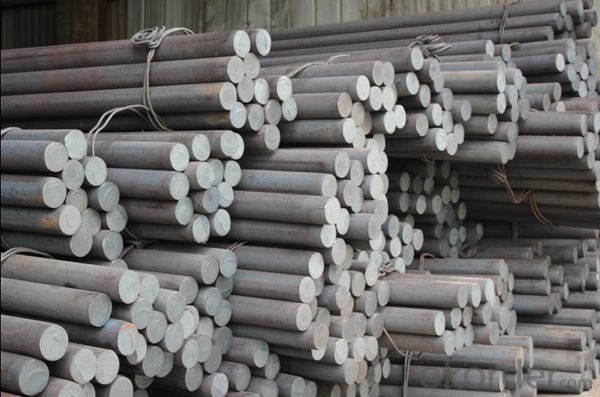
- Q:How do you use a steel square to determine cut angles?
- To use a steel square to determine cut angles, you can follow these steps: 1. Place the steel square on the material you want to cut, aligning one edge of the square with the edge of the material. 2. Find the angle you want to cut and locate the corresponding angle on the steel square. The steel square typically has a protractor scale on one of its sides. 3. Once you have located the angle on the steel square, mark the material using a pencil or a scribe along the edge of the square. 4. Double-check the alignment and ensure that the square is securely positioned before making the cut. By using a steel square in this way, you can accurately determine and mark the desired cut angles on your material, ensuring precise and consistent cuts.
- Q:How is a steel square used in construction?
- A steel square is used in construction as a measuring and layout tool. It is particularly useful for creating right angles, marking and cutting accurate angles, checking the squareness of corners, and determining measurements for cuts and joints. Additionally, it can be used as a guide for leveling, aligning, and squaring various components during construction tasks.
- Q:How do you use a steel square to lay out a tenon joint?
- To use a steel square to lay out a tenon joint, follow these steps: 1. Begin by measuring the width and thickness of the tenon piece and the mortise piece. This will help determine the size of the tenon that needs to be created. 2. Mark the shoulder line on the tenon piece. This line indicates where the tenon will stop and the shoulder of the joint will begin. Use the straight edge of the steel square to ensure a straight and accurate line. 3. Next, measure the length of the tenon on the tenon piece. This will determine how deep the mortise needs to be on the mortise piece. Mark this measurement on the tenon piece using the steel square. 4. Once the shoulder line and tenon length are marked, place the steel square against the edge of the tenon piece, aligning it with the shoulder line. This will help ensure that the tenon is cut at a perfect right angle to the shoulder line. 5. Use the steel square to mark the sides of the tenon on the tenon piece. Simply place the steel square against the edge of the tenon piece, aligning it with the shoulder line, and mark the width of the tenon on each side. 6. Now, transfer the marks from the tenon piece to the mortise piece. Place the tenon piece against the mortise piece, aligning the shoulder line with the desired location, and transfer the marks for the width and length of the tenon onto the mortise piece using the steel square. 7. Finally, use a saw to cut along the marked lines on both the tenon and mortise pieces. The result should be a perfectly sized and aligned tenon joint. By using a steel square to lay out a tenon joint, you can ensure accurate measurements and precise angles, resulting in a strong and well-fitting joint. Remember to always double-check your measurements and use sharp tools for the best results.
- Q:Can a steel square be used for measuring angles?
- Indeed, an angle can be measured using a steel square. A steel square, which is also referred to as a framing square or carpenter's square, is an adaptable instrument capable of conducting diverse measurements and layout assignments, inclusive of angle measurement. Typically, it possesses an elongated arm and a shorter arm that intersects perpendicularly, forming a right angle. By aligning the square with the object or surface under scrutiny, it can establish the angle between two lines or surfaces. Nevertheless, it is crucial to acknowledge that a steel square merely offers approximate measurements and may not possess the same level of accuracy as specialized tools such as a protractor, which are designed specifically for precise angle measurements.
- Q:Can a steel square be used for checking the alignment of walls?
- Yes, a steel square can be used for checking the alignment of walls. The straight edges of the square can be placed against the walls to determine if they are perpendicular or at the desired angle. The square can also be used to check for plumbness by aligning it vertically against the walls.
- Q:Can a steel square be used for measuring angles in masonry work?
- No, a steel square is not typically used for measuring angles in masonry work. Masonry work usually requires specialized tools like a mason's square or a protractor specifically designed for measuring angles in this field.
- Q:Can a steel square be used for wainscoting installation?
- Wainscoting installation can indeed utilize a steel square. A steel square is a tool that is both versatile and durable, frequently employed in carpentry and woodworking projects. Its primary function is aiding in the measurement and marking of right angles, as well as guaranteeing accurate cuts and joinery. During wainscoting installation, a steel square proves useful for marking and measuring the height and width of the panels, ensuring proper alignment and levelness. Additionally, it can assist in verifying squareness and making precise cuts when trimming panels to accommodate corners or obstacles. In summary, a steel square serves as a valuable asset for achieving meticulous and professional wainscoting installation.
- Q:Can a steel square be used for checking the squareness of a router table insert plate?
- Indeed, the squareness of a router table insert plate can be assessed utilizing a steel square. This trusty and precise instrument serves as a dependable means of ascertaining right angles and validating the perpendicularity of the insert plate with respect to the table surface. Placing the steel square against the plate's edges and ensuring a seamless fit devoid of gaps or overlaps enables one to determine whether the plate is flawlessly square or necessitates adjustments.
- Q:How do you use a steel square to mark out parallel lines on irregular surfaces?
- To use a steel square to mark out parallel lines on irregular surfaces, you would start by placing the square against the straight edge of the surface and aligning it with the desired angle or parallel line. Then, using a pencil or marker, trace along the edge of the square to mark the parallel line. Repeat this process at different points along the surface to ensure accuracy and consistency in marking out parallel lines.
- Q:How do you use a steel square to measure and mark compound angles?
- In order to measure and mark compound angles using a steel square, there are several steps that need to be followed. To begin, it is important to understand that a steel square, which is also referred to as a framing square, consists of two arms that meet at a right angle. One of the arms is longer, known as the blade, while the other is shorter and referred to as the tongue. The blade typically contains markings and measurements for various angles. To start the process, you must first determine the specific compound angle that you wish to measure and mark. This involves identifying the two individual angles that make up the compound angle. For instance, if you want to measure a compound angle that consists of 45 degrees and 30 degrees, you will need to measure and mark each of these angles separately. Next, position the steel square onto the material that you intend to mark. Place the tongue against one side of the material and align the blade with the other side. It is important to ensure that the square is firmly pressed against the material and that the blade is parallel to the tongue. Afterward, rotate the steel square until the desired angle is aligned with the material. Utilize the measurements and markings on the blade to determine the correct angle. For example, if you wish to measure a 45-degree angle, align the marking on the blade that indicates 45 degrees with the material. Once the first angle is properly aligned, use a pencil or marking tool to mark the material along the blade of the steel square. This will create a line that indicates the first angle. Proceed to repeat the process for the second angle of the compound angle. Rotate the steel square once again until the desired angle is aligned with the material, utilizing the measurements and markings on the blade. Mark the material along the blade to indicate the second angle. The point where the two marked lines intersect represents the compound angle that you wish to achieve. You can now use these marks as a guide for cutting, joining, or any other application where a compound angle is necessary. It is important to remember that using a steel square to measure and mark compound angles requires accuracy in aligning the square and reading the measurements on the blade. With practice and experience, your proficiency in effectively using a steel square for compound angles will improve.
1. Manufacturer Overview |
|
|---|---|
| Location | |
| Year Established | |
| Annual Output Value | |
| Main Markets | |
| Company Certifications | |
2. Manufacturer Certificates |
|
|---|---|
| a) Certification Name | |
| Range | |
| Reference | |
| Validity Period | |
3. Manufacturer Capability |
|
|---|---|
| a)Trade Capacity | |
| Nearest Port | |
| Export Percentage | |
| No.of Employees in Trade Department | |
| Language Spoken: | |
| b)Factory Information | |
| Factory Size: | |
| No. of Production Lines | |
| Contract Manufacturing | |
| Product Price Range | |
Send your message to us
Hot Rolled Round Steel Bars with Cr A36, Q235, SS400
- Loading Port:
- Tianjin
- Payment Terms:
- TT OR LC
- Min Order Qty:
- 25 m.t.
- Supply Capability:
- 200000 m.t./month
OKorder Service Pledge
OKorder Financial Service
Similar products
New products
Hot products
Related keywords
